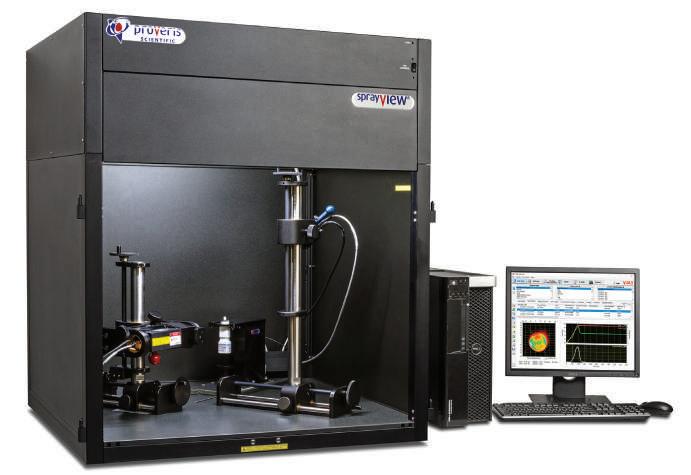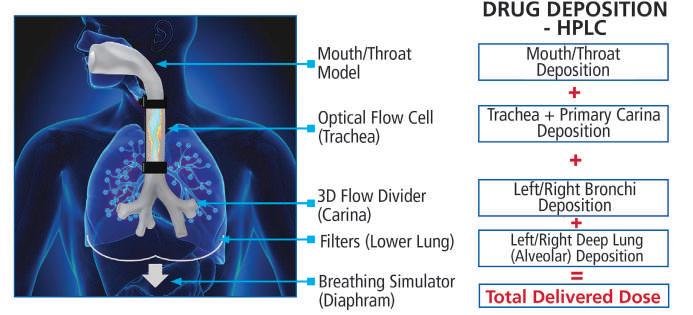
9 minute read
Respiratory Drug Development – Perspective from Spray and Aerosol Characterisation Expert
from IPI Spring 2021
by Senglobal
Dino Farina, Founder and CEO of Proveris Scientific
Q1: Who is Proveris Scientific and how do you fit into the landscape of respiratory drug development?
Since our founding more than 25 years ago, Proveris Scientific® has striven to help our customers develop optimallyperforming orally inhaled and nasal drug products (OINDPs) for patients around the world. We do this by delivering innovative testing platforms, laboratory services, and deep product knowledge to customers who develop, manufacture, or test OINDPs. As experts in spray and aerosol characterisation, we are perhaps best known for our flagship SprayVIEW® measurement system. The SprayVIEW system is designed to be an allin-one testing platform that has become the industry standard for measuring and analysing the spray pattern and plume geometry produced by spray- and aerosolgenerating devices. Both measurements are critical quality attributes (CQAs), indicative of the performance of combination drug products and sensitive to minute changes in device design and drug formulation, and patient usage as well.
These systems have been validated and are critical tools in both development and production environments at leading pharmaceutical companies, CDO/CMO/ CROs, device manufacturers, and regulatory agencies around the world. At the core of the SprayVIEW system are our line of Vereo® automated actuators, which allow for repeatable and controlled actuation of drug delivery devices including multi- and unit-dose nasal sprays, pressurised metered dose inhalers, and soft mist inhaler designs commonly incorporated in respiratory drug delivery devices. Human-realistic automated actuation has been suggested by regulatory agencies around the world as a key factor to decrease variability in drug delivery due to operator factors, thereby increasing the sensitivity for detecting potential differences between products in common in vitro tests.
Q2: In terms of contract services, what types of projects has Proveris Laboratories historically served?
OINDP development is driven by the needs of specific disease management such as: respiratory/lung diseases (e.g., allergies, asthma, and chronic obstructive pulmonary disease); central nervous system and neurodegenerative diseases (e.g., epilepsy, Alzheimer’s); pain management (e.g., cancer,
Proveris SprayVIEW measurement system is the industry standard for measuring and analysing the spray pattern and plume geometry produced by spray and aerosol devices. In addition, it offers users the ability to do bioequivalence studies and perform new measurements, such as plume front velocity and evaporation fraction. migraine); rescue treatments (e.g., seizures, drug overdose reversal); and more recently vaccine delivery. In general, inhalation and intranasal drug delivery offers a more targeted and accessible delivery route, thereby eliminating systemic exposure to the drug in question. This can be one of the reasons for choosing these delivery methods, as opposed to more common ones, such as oral tablets or injectables.
Traditionally, Proveris Laboratories, the CRO division of Provers Scientific, has been involved in helping customers develop and release combination drug products from the aspect of device characterisation and in vitro testing method optimisation. Our Proveris by Design™ approach helps our customers to unlock the complex relationships between formulation, device, and human usage. Very often we will start a customer project with an ergonomic hand study. This evaluates a customer’s device candidates (in some cases also an existing reference product if the project in question is a generic drug development project). With the utilisation of our patented Ergo™ technology, the corresponding velocity and acceleration profiles are measured. These parameters determine the optimum characteristics to properly actuate the devices according to the targeted patient populations.
Full characterisation services on the products in question can be provided using this information in conjunction with our Vereo automated actuator technology. Common in vitro tests involved in these characterisation studies include those listed in Table 1.
Q3: What major events have occurred within your industry and what effects have they had overall?
A3: During the 25 years of working with a wide variety of companies, we have seen developments in all major categories of inhaler and intranasal drug products. In the early 1990s, much of the innovation was driven by the ban on ozone-depleting chlorofluorocarbon (CFC) propellants and the switch to hydrofluoroalkanes (HFA). This

Table 1 event injected a spark of innovation into the field of OINDPs, leading to the development of a new generation of pressurised metered dose inhalers (pMDIs) using HFA formulations, as well as technological advancements across all other major device types. These advancements include: new dry powder inhalers (DPIs) that required no propellant but instead rely on a quick, deep inhalation to draw the drug into the lungs or nasal passage; soft mist inhalers (SMIs) that require no propellant but instead use the mechanical force of a spring to turn a solution of medication into an aerosol; nasal atomisers for nose-to-brain (N2B) delivery; and the development of vibrating mesh systems in nebuliser technology. Another event that has had a major impact and caused our healthcare system to adapt is the opioid crisis. An urgent need for drug overdose rescue drugs led to the development and US FDA approval of singledose nasal spray NARCAN® in 2015, and the first generic naloxone nasal spray four years later in 2019. New device types were developed for this type of drug which are now referred to as unit-dose devices. Today,


Different configurations of Vereo Automated Actuators: (from left to right) SFMDx for pMDIs; NSx for nasal/oral sprays; DSx for dual-sided sprays and SSx for side-actuated nasal sprays. Vereo actuators are designed to model human-usage of orally inhaled and nasal drug products, ensuring precise control of important actuation parameters, including force limit, position, velocity, acceleration, and timing. Together with Viota software, the systems generate data to help evaluate device performance, and let drug developers investigate position and force profiles for each actuation. the coronavirus pandemic is driving R&D for SARS-CoV-2 preventatives, therapeutics, and vaccines delivered via inhalers and intranasal delivery methods.
Finally, regulatory agencies are working to reduce barriers to generic development and to lower the cost of generic entry into the marketplace, spurring an increase in options for patients. The US FDA, for example, has been pushing for increased generic competition as one means of lowering prescription drug prices. As novel products are introduced and technological advancements occur, new and updated regulatory guidance documents are published to accommodate this effort. In the United States there are 40-plus new or updated guidance documents. In Europe, the European Medicines Agency works with the European Directorate for the Quality of Medicines on matters aimed at ensuring the quality of medicines and protection of public health. The European Pharmacopoeia 10th Edition (2019) Monographs provides guidance for nasal and inhalation products to the Council of Europe’s 38 Member States, of which six are European countries and 22 are non-European countries.
Q4: What role do Proveris Scientific instruments and services play in assisting your clients on their journey to commercial success?
We engage with companies from early product development through to commercial release with our wide array of products and services. Following the drug development process outlined by the US FDA, step 1 is described as the discovery and development phase. Late in this stage, companies are assessing delivery options for their drugs. If evaluating orally inhaled and nasal drug products as an effective route, Proveris can provide a wide array of instrumentation and test services depending on the device type. Common test services include device characterisation, formulation screening, and hand studies. At step 2, safety and toxicity assessment, we help our clients establish a baseline performance for their products in our cGMP-compliant laboratory which is equipped for in vitro testing to support pilot-scale batch testing. Customers will use our advanced characterisation tools and capability for a wide range of in vitro testing to make key adjustments and decisions on things like formulation and device design before entering the clinical phase
(if necessary). Our tools allow customers to assess their products accurately in vitro and bridge the gap between in vitro and in vivo – a significant goal, especially in the development of a generic drug. Moving into step 3, clinical research phase, we have technologies to help with clinical end-point studies that are needed for product approval. After step 4, FDA review, customers will move into step 5, post-market safety monitoring. It is in this phase when customers will utilise our core instruments, such as our SprayVIEW measurement system, Vereo automated actuators, Kinaero™ high-throughput firedown system, Indizo® automated collection system, and Viota® software to enable them to scale up their manufacturing with stability testing and QC batch release testing that is required from a post-market approval perspective.
Q5: Pharma, higher education, and focused industry groups are fully engaged in the pursuit for solutions to combat COVID. Can you briefly describe the projects you are seeing related to this effort?

Proveris Scientific’s INVIDA platform is an example of an offering that helps clients bridge the gap between in vivo and in vitro by providing a human-realistic model of the human respiratory tract. Proveris can tailor custom studies to offer clients a visualisation of the drug as it moves through the throat, as well as quantified deposition of the dose in order to study where the drug is reaching.
In early April 2020, we began a collaboration with Mass General Brigham (MGB) Center for COVID Innovation in Boston, Massachusetts USA on a respirator mask project. The MGB COVID Innovation Group (covidinnovation. partners.org) is a partnership of Massachusetts General Hospital and Brigham and Women’s Hospital, two of the world’s most prestigious hospitals and research institutes, known for their teaching and training association with Harvard University’s School of Medicine. MGB is working with Proveris to provide testing and feedback on our respirator mask designs. In addition, we have projects with research and development groups for nasal spray prophylactic therapy to prevent people from getting coronavirus, again leveraging our core competence in nasal spray, particle capture, and so forth, just now using them in the reverse. We



The Kinaero high-throughput fire-down system ensures reproducible actuation throughout pMDI product life testing. It offers programmable shaking angle, frequency, duration, and inter-actuation delay along with multiple modes of actuation (force, position, or time-based) for flexibility during automated fire down. Universal cassettes allow for variability in different device dimensions and unique design features offering maximum versatility to accommodate future devices have also had several companies come to us for contract test services through our cGMP-compliant laboratory for device characterisation work on intranasal vaccine candidates for COVID-19. After the release of the major vaccines currently available (Pfizer, Moderna, AstraZeneca, etc.), we believe you will see a next wave of approvals for different delivery methods, including ones in the inhaled and nasal delivery spaces. These types of innovations will help lessen the burden on distribution and administration of the vaccine which will be key in certain populations and rural areas. So, while the coronavirus pandemic has been a horrible thing to have to deal with, the staff at Proveris are fortunate to be among the frontline effort to help in the fight. We are proud to take on a mission as large as this one and include it in our core values for the organisation.
Dino Farina
Dino Farina is a business owner and inventor. His expertise is in optical measurements of fluid flow, experiment design, analysis, and pharmaceutical regulatory science. He is the named inventor on over 40 US and international patents. He holds two master of mechanical engineering degrees from Stanford University, and is the recipient of the prestigious NASA Student Fellowship grant to study advanced fluid dynamics at the NASAAmes Research Center in Mountain View, California.










